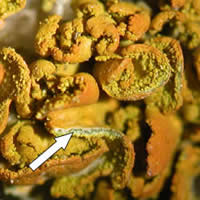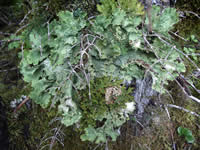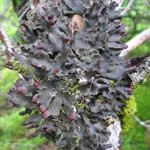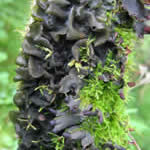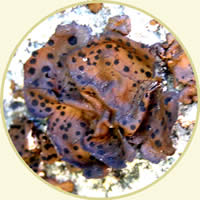USDA Forest Service Celebrating Wildflowers
|
|
|
 |
|
Lichen BiologyStructureLichens do not have a waxy cuticle like plants have on their leaves, nor do they have vascular tissue such as xylem and phloem to move nutrients and water around their thalli as a plant does. Everything in the lichen’s environment is absorbed into the lichen's structure. Lichens get their water and nutrients from their surrounding environment via air and rain.
The general structure of a lichen is composed of layers of fungus and alga. CortexThe cortex is the outer layer of the lichen thallus. These cells are thicker and more closely packed than the other fungal cells in the lichen. This layer provides some small measure of protection, as well as provides color in some species. Algal LayerYou can usually tell what kind of alga a lichen has just by color alone. When a lichen is dry, its color is usually gray or colored like the fungal cells on the upper cortex. When a lichen is wet, those cells become transparent, and the algal cells underneath get a chance to show their vibrancy. Green algae generally give the lichen a bright green color when wet, although there are exceptions of pigmented lichens with green algae due to the fungal partner showing its colors. Cyanobacteria can be a layer under the upper cortex or in tiny pockets on top of the upper cortex if there is a green algal layer already present. Cyanobacteria will give the lichen a dark green, brown, or black color. In some lichens, however, there are no layers of fungus and alga. The individual components are mixed together in one big uniform layer and the resulting growth form is gelatinous. These types of lichens are called jelly lichens.
MedullaThe majority of the lichen thallus is comprised of fungal filaments called the medulla. It is made of fungal cells that are loosely packed in the middle of the lichen thallus, have thin cell walls, and are threadlike. The result is a cotton-like substance underneath the outer cortex. Basal Attachment
Lichens attach to their substrate by different means. Rhizines are fungal filaments that extend from the medulla and attach the lichen to its substrate. Rhizines have no vascular capabilities like the roots in plants. They do not move water or nutrients to the lichen; they simply hold the lichen down to whatever it is sitting on. Holdfast is an extension of the lichen thallus. Instead of many rhizines, some lichens have a central peg or holdfast that attach to the substrate, generally a rock. These types of foliose lichens are called umbilicate lichens, since the central holdfast is like an umbilical cord. |
|
| NOTE: PDF format links require the Adobe Acrobat Reader to view. | |
| top | Disclaimers | FOIA | Privacy Policy | Quality of Information | Photo Credits & Use |
Location: http://www.fs.fed.us/wildflowers/interesting/lichens/biology/index.shtml
Last modified: Tuesday, 24-Jun-2008 21:54:31 EDT
